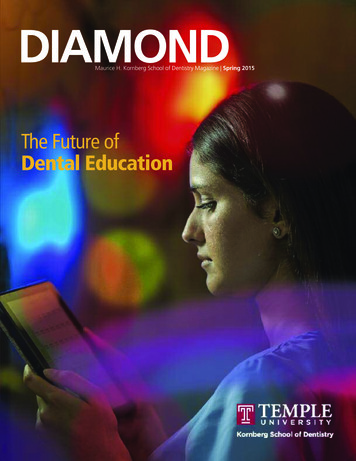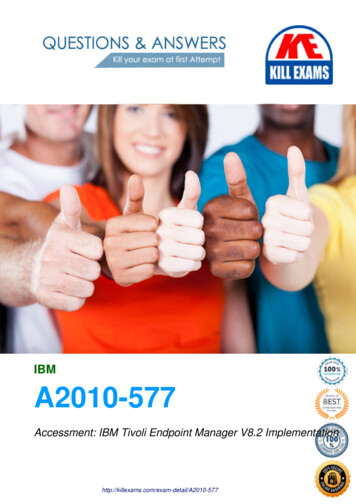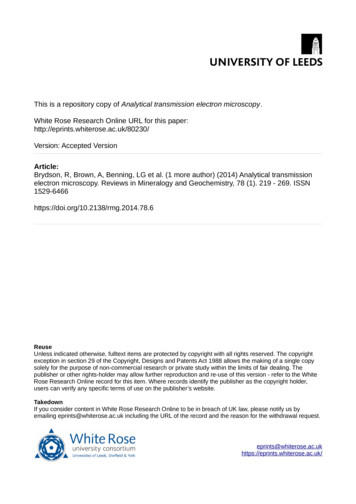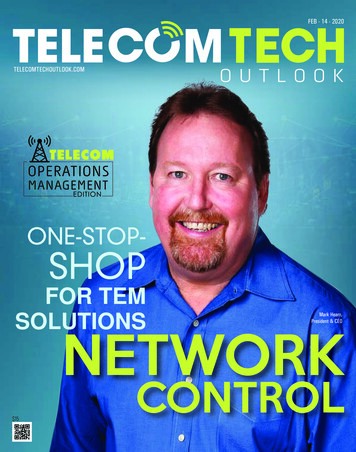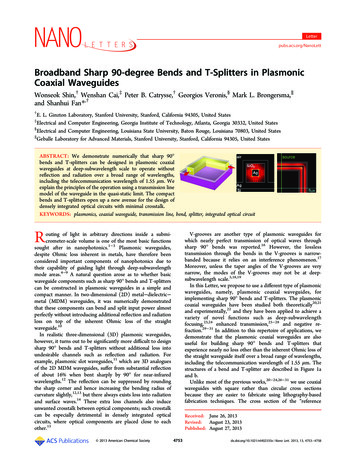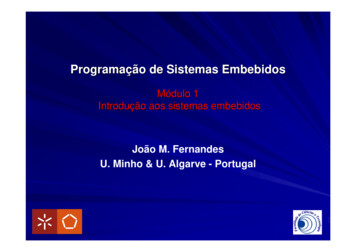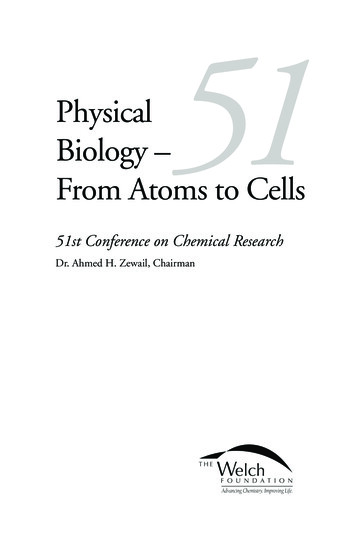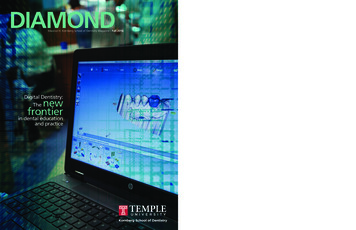
Transcription
DIAMONDMaurice H. Kornberg School of Dentistry Magazine Fall 2016Digital Dentistry:Thenewfrontierin dental educationand practice
DIAMONDMESSAGE FROM DEAN AMID I. ISMAILMaurice H. Kornberg School of Dentistry Magazine Fall 2016How We’re Approaching theDawn of a New EraContents1 How We’re Approaching the Dawn of a New EraAmid I. Ismail, BDS, MPH, MBA, DrPH, Dean3 Kornberg at Forefront of New Era with Digital Dentistry6 Dr. Thomas J. Balshi: Embracing Advanced, Efficient Technology8 Dr. Robert M. Bentz: What’s Needed as Digital Dentistry Evolves?10 Dr. Gary Kaye: An Exciting Time to Be a DentistPage 412 New ResourcesNew Partnership with GPHA, Inc. to Integrate Medical and DentalCare13 Introducing the Diagnostic Imaging and Interpretation Center at theOral and Maxillofacial Radiology ClinicPage 1214 Focus on FacultyOur Newest Faculty Leaders:Furthering Temple’s Vision for Dental EducationDr. Nina GhobadiDr. Judith McKain-RubinDr. Carmen DoumitDr. Farah HaroonDr. Stanley J. HeleniakDr. Austin LeongDr. Nezar Noor Al-Hebshi18 Student Spotlight2016 White Coat Ceremony19 2016 Temple Dental Graduation20 Compelled To Serve: Fourth-Year Dental Student Paige Epps SharesPassion for Community Dentistry21 From Puerto Rico to Pennsylvania: Dr. Xiomara Y. Rivera-Hernández’sDental Journey22 Learning Customization and Efficiency to Enhance Patient Experience:Dr. Kaitlyn SchielsPage 1823 New ProgramsA Global Center for Advanced Dental EducationAs I reflect on the 153 years of our dental school, this thoughtamazes me: The Philadelphia Dental College, Temple UniversitySchool of Dentistry and now the Maurice H. Kornberg School ofDentistry have experienced every step of dental practice development— from the time before amalgam and restorative dentistrystarted in the late 19th century, to the electric power revolution ofthe early 20th century, to the emergence of modern-day practicematerials and instruments.Just as important to realize is that throughout this progress, our faculty and alumni have been pioneers in the dental field. They adoptedrestorative care early in the G.V. Black era and then nitrous oxide anddental implants. Even now, our faculty are moving toward usingemerging technologies as this rich history in dental education andpractice continues.For instance, in this issue you’ll read about a new medical clinic,which will be home for a medical-dental integrated practice unit andhealthcare coordination center. The clinic represents the early stagesof a new dental practice model for patients who are older and havecomplex medical, social, behavioral and pharmacological histories.You’ll also want to look at articles about the practice of the future.It’s digital and “in clouds,” and we’re responding with a new digitaldentistry program initiated with a generous equipment contributionfrom Henry Schein, Inc. As we develop the program’s Center forExcellence in Digital Dentistry, our faculty will be engaging incutting-edge application and research of new digital techniques inpatient care.Dean Amid I. IsmailLaura H. Carnell Professor24 AlumniAn Interview with Allen Finkelstein, DDS, Class of 196926 Dr. Leonard Goldstein DEN ’80: “I’ve Always Been a Planner”Planned Giving27 Alumni Association News28 Reunion 201630 Class Notes31 Student Notes32 Continuing Education CoursesPage 2433 In Memoriam“Clearly, we envision a day when all impressions willbe digital and designs of all prostheses and fabricationwill be managed electronically. So, within a decade,our museum of outdated equipment will haveimpression trays and materials, carving instruments,dental wax and all burners.”— Dean Amid I. IsmailDiamond Fall 20161
WHAT'S HAPPENING NOW. WHAT TO EXPECT IN THE FUTURE.Kornberg at Forefront of New Era withDigital DentistryClearly, we envision a day when all impressions will be digital and designs of all prostheses and fabrication will be managed electronically.So, within a decade, our museum of outdated equipment will haveimpression trays and materials, carving instruments, dental wax andall burners.As we stay very focused on how we approach the dawn of this newera, we're taking one more step. It’s collaborating with Temple University’s renowned Tyler School of Art to recruit digital dental artists.In the research area, we're also initiating a progressive program. It’sinvestigating the oral microbiome, which will create new knowledgeon etiology of dental caries, periodontal diseases and oral cancer. Wewill start with two new research faculty who have been recruited towork with a multidisciplinary team at Temple University and withother national centers of excellence in this field. It’s a new journey indentistry.In education, we’ve implemented new methods to evaluate the competencies of our students. Within a month, our InsightDentTM application will be accessible from all smartphones and personal computersand allow dental educators and practitioners to share real-life patientcases and discuss them in an open forum. This tool should help calibrate faculty and dentists and develop a learning organization.Finally, we’re building on our record as one of the earliest adopters ofnitrous oxide use. Just completed is a new Sedation Center. It’s providing care under different levels of conscious and unconscious sedationto patients who can be treated in a general practice setting on anoutpatient basis.I hope that as you read this issue of the Diamond, you’ll feel PROUD ofour rich and long history and how we’re shaping the future of dentaleducation and practice. Then I hope you’ll support the dental schoolas a contributor, faculty or alumna/alumnus grateful for our newdirections.Digital dental:the basicsBecause digital dentaltechnology is developing soquickly, understanding itcan be a challenge andimplementing it even morechallenging. However,components of the latestadvances can generally bedivided into four areas:Jessica Williams, Class of 2017Audrey Lane, a Temple dental patient since 2000, sat in theclinic chair waiting for her new crown. She was the focus ofmore than the usual number of clinicians. The day, March 2, wasslated for demonstrating digital dentistry procedures, and a smallgroup of students and faculty surrounded her. She opened hermouth for the 3D scanner, happy not to have impression materialon her teeth. Laser intraoral scannersTo discuss how you may be able to help our dental school, please emailme at ismailai@temple.edu or call me at 215-707-2799. 3D milling and printingdevices and materials Patient and officemanagement systems Digital lab solutions2Diamond Fall 2016Then and NowWith their chairs placed next to windows fornatural light, early dentists had only rudimentary ways of seeing into a patient’s mouth.Today, dental scanners can easily, comfortablyand accurately pick up the smallest detail,even at the back of the mouth.As Audrey’s prepared tooth site and adjacent areas showed up onthe monitor, fourth-year dental student Umme Hafeez rotatedimages for additional views. Then, quickly finishing her final design, Hafeez saved the images to a disk, which was taken upstairsto the preclinical lab for milling. In less than 15 minutes, Audrey’scrown was ready for placement. She would have gone home afterjust half an hour, but noting the color wasn’t quite right, Hafeezquickly had another crown milled by the lab.Diamond Fall 20163
WHAT'S HAPPENING NOW. WHAT TO EXPECT IN THE FUTURE.But now is digital dentistry’s big moment. Enough technological advances have occurred in the past few decades that the way patients aretreated is about to dramatically change. Putting the breadth of changein perspective, Dr. Aaron Segal, associate professor clinician scholar inrestorative dentistry, said, “In our students’ lifetime, digital dentistry isthe only thing they’ll use.”Added Dr. Robert Gottlander, chief marketing officer of Henry Schein’sGlobal Dental Group, “Now is the time to treat patients in a differentway. We can improve quality, see what our eyes aren’t seeing, showpatients the images and use trained team members such as hygienistsand assistants to work with the dentist. And with this program Templeis in a leadership position, in the forefront globally. Most dentalschools are just experimenting.”Asked why Kornberg is taking this dramatic step, Dean Ismail pointedto the school’s mission. “Our legacy is to provide care to those in need.This technology will have a life-changing impact on those we serve.Crowns and bridges are especially needed with low-income populations. Eventually, we’ll do dentures, too. With no noise, no shaking,more comfort and efficiency, we’ll be able to treat more people andpass on the cost savings to them.”In fact, Kornberg’s clinic visits have increased 20 percent during the lastthree years. Anxious to increase patients’ access to high-end procedures, the dean said the result will also benefit the school. Foreseeinga bank of images, he explains, “We’ll have a baseline scan of everypatient, and that will create a database to teach and learn from.”Thrilled with the result, Audrey asked, “Can you tell which tooth it is?”In every way, the crown looked completely natural. “This is amazing,”she said later, comparing the experience to previous crown work. “Nopain, no waiting for hours. I can go about my business and could evenbite an apple today.”4Diamond Fall 2016The DifferencesAre AstoundingHenry Schein’s relationshipSchein’s relationship with the dental school is longstanding. “We havelong-term trust built over several decades,” said the dean. “That’s onereason Schein chose Kornberg for the pilot program. Another is theschool’s legacy of cutting-edge dentistry. Still another is the faculty.”According to the dean, “They want to do it. They want to teach it.”While increasing comfort and convenience, digital dentistry shouldalso decrease cost. Advances in technology mean efficiency throughoutthe process—in the chair and at the milling lab. Also, if something happens to a crown or bridge, patients can call and easily get a new one.That’s because the digitized image is saved in an easily accessible database.Now is digital dentistry’s big momentWe know the basic technology. Scan something, manipulate theimage, save the design to disk, then pop that disk into another computer that prompts final output from yet another machine. It allsounds fairly straightforward, and it is. In fact, digital capability indentistry has been around since the 1980s.Top: Digital dentistry in actionAbove: Henry Schein's Dr. Robert Gottlander,back right, confers with (clockwise from frontright) Dean Amid Ismail, and faculty membersDr. Aaron Segal and Dr. Mark Meraner, duringthe launch of the Henry Schein Digital Dentistryprogram.But for Schein, “It’s not about providing free equipment to theschool.” Explained Gottlander, “The real trick is making the programwork, tracking what goes on, seeing how to improve. It’s about providing training, organization, leadership and support.”Top: Audrey admires her new smile in progress.Above, a view of the milling machine, outsideand in.For Audrey, and the five other patients who benefited from digitaldentistry on March 2, their glimpse of a new era was astonishing and“awesome.”Only 30 minutes in the chair fora new crown? And that includes15 minutes of milling time?Digital dentistry has certainlycome of age. In the forefrontnationally and even globallyamong dental schools teachingthe procedures is Kornberg.Helping with equipment—10 scanners and three millingmachines—plus training andsupport for a pilot program,launched March 2, is HenrySchein, Inc.Diamond Fall 20165
WHAT'S HAPPENING NOW. WHAT TO EXPECT IN THE FUTURE.Three practitioners share their experience and insightsEmbracing advanced, efficient technologyand 16 other U.S. markets. She came to Balshi fortreatment and then went on TV with her story because her extreme condition of periodonticallyhopeless teeth and bone atrophy could show otherswhat is now possible in a few reconstruction visits.A video series shows Balshi first stepping in with aday of molding, imaging and measuring after herprimary dentist did extractions. That prep workhelps plan surgery for her next visit when Balshi andhis team remove the remaining teeth before puttingin implants and screwing them to a temporary digital denture. Later, when the permanent denture isbuilt, he uses an in-house scanning lab and anArizona-based lab to produce robotically milledteeth in dental ceramic for the top and in a strongeracrylic for the bottom. Then, artful coloring andcarved veining go through crystallization to makethe denture look real. Once secured in place, the setdelights Jackson “with a new mouth” that “looksbeautiful!”Thomas J. Balshi, DDS, PhD, FACP, ’72, develops a strategic digital plan with Stephen F. Balshi, biomedical engineer. Dr. Balshi, founder ofPi Dental Center in Fort Washington, Pa., provides patients with monolithic, fully milled digital dentures as well as with implantsupported, fixed prostheses.Remember Jurassic Park?” asks Dr. Thomas Balshi.“When Billy takes Dr. Grant into the tent toshow him the rapid prototyper? It’s stereolithography, printing 3D from layers of 2D images. And it’swhat we can do with digital dentistry.”For instance, 2D data files can be put into othersoftware to see the 3D surgical plan. That’s then thebasis for templates to show where the implants andteeth will go. “It’s similar to the stencils that kidsuse to draw,” says Balshi. And it’s all part of today’sCAD/CAM restorations, which Balshi assures are better fitting, more durable and more natural lookingthan ever before.“The future will be a unifiedworkflow It will just be moreelegant and streamlined.”— Dr. Thomas J. Balshi6Diamond Fall 2016He uses the technology in several ways: for patientswho would normally need six to eight implants andnow can have four that secure a digital dental prosthesis—or for a permanent digital denture anchoredwith four to six implants. In either case, the reconstruction uses a robotically milled prosthesis on atitanium-milled framework. He emphasizes that theproprietary surgical procedure, which he developedwith Global Dental Science, is faster and simplerthan others and is streamlined with the patient’sdigital records to provide permanent digital recordsfor future “teeth forever.”Minimally invasive procedureClearly, the benefits of this surgery are a boon tosuch patients. Despite the severity of their bone atrophy, they usually undergo a single surgical procedure that is minimally invasive, avoiding bonegrafting. “It’s precise just like a Swiss watch,” Balshisays. “The fit is excellent due to robotic milling of anentire piece rather than individual teeth. Also, thedigital denture is more comfortable than standarddentures, 50 times stronger and resists bacteria dueto the nonporous, bio-hygienic material.”with others using the technology who say it achieveshigh patient satisfaction because patients spend lesstime with the dentist and can approve a design onthe computer screen before milling. It is rewardingfor dentists, too, because what used to take 100hours of labor can now be done at the push of abutton.What does he see for the future? “Robotics will beplaying a greater role,” he says. Also, he believesthat today’s dental students—familiar with manipulating images in 3D—will make an easy lateral shiftto the new technology. That’s important because hewould like students “to pay close attention to current technology trends as they will be critical forestablishing a successful dental practice.”In addition, he looks forward to open platforms andshared files as applications talk to each other, withdata from one program connecting with anotherand with one business enterprise linking to another.“The future will be a unified workflow. There weretoo many closed platforms before. It will just bemore elegant and streamlined.”Watch the videos!Explaining further, he says, “The patient’s anatomydetermines the distribution of implants in the arch.For instance, the sinuses may dictate implant positional angulation.”For a digital dental prosthesis, “It’s an economicshift in treatment protocol,” says Balshi, “sincethere are fewer implants.” For digital dentures, theprocess can take what Balshi calls “a failed situation” and turn it into “what looks normal again.”He adds: “We can be an instant orthodontist,morphing teeth, making them longer or thinner orrounder, positioning them correctly on the archform.”A case in point is Patty Jackson, WDAS radio’s R&Bsoul “mid-day maven” well known in PhiladelphiaThis kind of expedited care that provides excellentresults with increased chairside comfort is the backbone of digital prosthetic dentistry. Balshi agreesSee radio personality Patty Jackson’s journey to health and perfect teeth.Fox News has documented Dr. Balshi's complexreconstruction in a series of three videos:www.youtube.com/watch?v E3qeJZnUuA0www.youtube.com/watch?v 78t67MRUTtQwww.youtube.com/watch?v FUiDtk6lng8Diamond Fall 20167
WHAT'S HAPPENING NOW. WHAT TO EXPECT IN THE FUTURE.?Answering the question:What’s needed asdigital dentistry evolves?She had just arrived at college as a freshman. Sitting on her dorm room bed, she smiled, and hermother captured the big wide grin with a quickphoto. Then she sent it immediately to Dr. Robert M.Bentz as a breakthrough moment to remember—because digital dentistry had turned her daughter’slife around.Recalling the recent rehabilitation, Bentz describesthe situation. When the 17-year-old first came tohim, she presented with the dentition of a 10-yearold. She was congenitally missing all her permanentteeth, and the primary teeth she did have werestarting to come out. So she was very self-consciousand worried about fitting in at school. She had evenconsidered not going to college. But with digitallydesigned prostheses, she was able to attain thebright smile she always wanted.Just as dramatic was his treatment for a seven-yearold boy with ectodermal dysplasia. Using digitaldentistry, Bentz fabricated a denture that canpromptly be replaced if the boy breaks or loses it.Because a digital file is recorded, the only chair timerequired will be to deliver the new denture. And“as he grows, we’ll rescan to create new denturesthat can be adapted to grow with him.”Robert M. Bentz, DMD, FACP, ‘93, has been working withdigital dentistry for about a decade, and uses it every day.Years earlier, when digital dentistry was only beginning to develop, Bentz worked on an 86-year-oldman known to be one of the oldest ectodermaldysplasia patients in the U.S. Since then, Bentz hasexperienced firsthand how precise the newestdigital technology has become. “It allows advancedsolutions that were not available to us in predigitaldentistry,” he says.He explains: “We get predictable results. When apatient comes in, we combine diagnostic recordswith converted DICOM files to create a 3D digitalrepresentation of the patient’s relevant anatomy.8Diamond Fall 2016With this, we can then digitally design the prosthesisand virtually run through our planned surgery righton the computer. We are creating and perfectingthe design before the patient is even seen in the office for surgery.” What helps with accuracy, he says,are cone-beam computed tomography and computer-aided guides for implant surgery. Timing, too,is improved. With a commercial lab on-site, heachieves quick turnaround for these digital designs.With half his time spent on the computer designingthe prosthesis and the other half spent completingthe procedure, Bentz is confident that each designfor a crown, bridge, inlay, or any prosthesis willwork with the stresses and load forces it will endure.He makes sure the design meets the digital conceptsas well as the patient’s needs.“Even with advanced technology and biomedical engineering to lay the foundation, there is still a highdegree of art in dentistry,” says Bentz. “We have toremember that the engineers aren’t dentists. So asthe practitioner, we must create quality control toeffectively guide the technology offered by ourengineers.”Technician trainingIn today’s world of digital dentistry, Bentz recognizes the need for more lab technician training.“Dentists are just too busy to do it all,” he says. Infact, he thinks many are overwhelmed with theBringing Dentistry to the ArtsDean Amid Ismail also recognized the need forqualified lab technicians to keep up with the production demands of the digital age and so proposed an experimental partnership with Temple’sTyler School of Arts. He sent a recent Tyler graduate, who studied CAD/CAM jewelry design, to alarge commercial lab for training, and now hasbrought him to Kornberg’s lab for a year to see ifthis might be the beginning of a beautiful collaboration between the arts.and the art of dentistry.“We are creating and perfectingthe design before the patient iseven seen in the office for surgery.”— Dr. Robert M. Bentzthought of adding digital dentistry to the workloadthey already incur. So he asks, “Who is training thetechnicians?” This question, once answered, “willhelp create a functional workflow in an office thatalready implements digital dentistry,” he predicts.“It also will encourage the reluctant dentist to putdigital dentistry into practice.”Another important point, he believes, is to take yourtime when working digitally. “Digital dentistrystarted blowing the doors off impression dentistryabout a year ago. Going through the growing painsis one of the biggest hurdles. New products are coming out, and they’re the future. But nothing is easywhen you first use it. Procedures take longer untilyou master them, and balancing the training withpatient time can be a frustrating task, especiallywhen you are trying to run a successful business.”He also cautions that dental students must understand and be able to implement core dental concepts. They must recognize the importance of usingtheir minds first before the computer does the work.“We can’t let go of the analytical thinking.”Despite these issues, Bentz says, “The future is exciting.” Enthusiastic about what's coming next, he seesa solid movement toward eliminating traditionalimpressions and creating cleaner, more precise outcomes in a more efficient manner that will minimizehuman error. “I can’t wait to find out where we’regoing with this vast world of digital dentistry.”Diamond Fall 20169
WHAT'S HAPPENING NOW. WHAT TO EXPECT IN THE FUTURE.tient even leaves the office. Then the outside labships back the restoration overnight, or a few dayslater for complex cases. Maybe best of all for patients, they avoid a mouthful of impression material.As a result, Kaye’s high-volume practice attracts people from all over the world.“Many patients travel to us,” he explains, “and timeis a challenge for them. Before, they needed multiple visits. Now, a lot can be accomplished in onevisit.”The efficiency of a quick restoration can be dramatic. “Recently, a bride-to-be broke two frontteeth just a week before her wedding. In one visitwe took care of it. And we did it without any specialarrangements with the lab.”In another case, a patient undergoing cancer treatment broke her tooth. Not wanting to compromiseher medical care, Kaye was able to give her a crownin one day.Anexciting time Dto be a dentistSee the comfort and convenienceof a digital procedureDr. Kaye goes step by step through a restorationat: www.youtube.com/watch?v 6r8d8GmEEWUr. Gary Kaye is plugged in—with his website,blog, interviews, videos, articles and perhapsmost importantly, with digital dentistry, one of theprime drivers of it all. Kaye’s practice is generaldentistry, and early on, he saw the advantages andpotential of CAD/CAM for restorations. In fact, thatwas 20 years ago. An early adopter? No question.Ask Kaye where he was with the technology twodecades ago and where he is now, and he describesa continuum of advances. At first, inefficiencieswith two different, unconnected systems for digitalX-rays and CAD/CAM were a frustration. Complexrestorations, too, had issues. Although much fasterthan before, they were still a lengthy process, taking two weeks to get mailed back from the lab.And now? All his digital and office technology is integrated. And with digital intraoral scanning, a labtechnician starts designing a crown before the pa-10Diamond Fall 2016With almost 100 percent of his impressions donedigitally, Kaye's practice is growing. In the past 10years, he is up from four chairs to 11 and hasmerged with several practices. Word of mouth,not advertising, helps with marketing. The reason:Patient satisfaction leads to profitability. So, too,do cost savings in materials and lab handling andalmost no remakes due to scan accuracy.“Digital is how we practice,” he emphasizes. “Justlike film went away for cameras, film is going awayfor dentistry.” He continues, “The tasks we do aremore predictable. We can see immediately if some-thing needs to change. Such accuracy means we’ll bedoing full dentures, not just partials, in a year.”Getting patients engaged“The trick is to get them engaged,” he says. “Engagedpatients will take better care of themselves. They willfloss and brush their teeth.” Just as valuable is the digital record that gives Kaye a visual history of patientchanges over time. Digital technology also means patients get more involved in the process. “They can seea 3D image on the screen, understand the changes andknow what's going on with the repair.”Are today's dental students ready for these advances? “Yes!” is Kaye's resounding answer. “They’remost enthusiastic about digital. They really endorseit because they've been exposed to it their wholelives. They’ve seen technological advances in everyday life and think it is how it should be done.”For those already in practice, Kaye realizes that thechanges are more difficult. That’s why he creates a100-day road map of implementation for each newtechnology introduced in his office. It’s also why hewas at Kornberg in August to give a lecture andthen gave intensive hands-on training to faculty athis digital New York City teaching center. In September, he was back again with a lecture series.“Temple is ahead of the curve,” he notes. “Templestudents will be very well prepared going forward.”Commenting on where dentists are today, he adds,“Digital technology exceeds our expectations. Ouroptions are expanding. There are no limitations.There's a boat, and it’s time to get on the boat.”Just two reasons why Dr. Kaye uses digital dentistry “When I magnify digital images on a screen,especially the 3D cone-beam images, to showa patient, it is mind blowing. With 3D we canpick up pathologies that would not be seenany other way. We can tell a patient with significant certainty what is going on. It is agame changer, and anyone who is using itwould not work without it.” “Patients ask about same-day restorations.They want them. Chairside, same-dayCAD/CAM alone has improved profitability toour bottom line in the last three years. We aredoing the same thing in half the number ofappointments, so it has to have a positiveeffect!”Diamond Fall 201611
NEW RESOURCESIntroducing theDiagnostic Imaging andInterpretation Centerat the Oral and MaxillofacialRadiology ClinicNew Partnership with GPHA, Inc.to Integrate Medical and Dental CareIn early 2016, Dean Amid Ismailof Temple University KornbergSchool of Dentistry and Mr.Ronald Heigler, CEO and executive director of Greater Philadelphia Health Action (GPHA), Inc.,took the first steps toward establishing a transformative new partnership to integrate medical anddental care. That vision wasrealized with the opening of theGPHA, Inc., Medical Suite at Temple University Kornberg School ofDentistry on June 2, 2016. The occasion drew many notable guests,including state Senators ShirleyKitchen and Christine Tartaglione,and Pennsylvania Governor TomWolf—perhaps the first time a sitting governor has visited the schoolsince Governor Curtin visited DeanMcQuillen around 1863.“The patients we see in the clinicfrequently have complex medical12Diamond Fall 2016needs,” says Dean Ismail. “Toooften, we were unable to immediately provide the dental care theyneeded because of underlying medical issues. To be a true healthcarehome, we must be able to offerpatients integrated, comprehensivetreatment.”GPHA is an ideal partner in thispursuit. For over 45 years, GPHAhas provided an array of medical,behavioral health, dental and childdevelopment services to underserved communities at a dozen locations. Like their other locations,GPHA’s medical suite at TempleDental is a federally qualifiedhealth center (FQHC), and offersboth treatment and preventativehealthcare services.“It is a transformative and uniquepartnership that increases the levelof care we are able to provide pa-Did you know that there are only a handful ofboard-certified dental radiologists in the entireCommonwealth of Pennsylvania? And two ofthem are faculty members at Temple Dental.Top, celebrating the grand opening; above, Pa.Governor Tom Wolf speaks at the ceremony.tients and gives our students valuable experiences and perspectiveson integrated care delivery,” saysDean Ismail.Governor Wolf congratulated thepartners in his remarks at the grandopening ceremony, and commentedthat “this type of collaboration represents the future of healthcare.”Sen. Kitchen agreed, noting that“Here, the doctor and the dentistwork together. No one else is doingthat.”Dr. Mustafa Badi and Dr. Jie Yang lead the DiagnosticImaging and Interpretation Center (DIIC) at the Oraland Maxillofacial Radiology Clinic here at the Kornberg School of Dentistry. They are both internationallyrecognized experts in their field, and both hold leadership positions with the International Association ofDento-Maxillo-Facial Radiology. Dr. Yang is the president-elect, and Dr. Badi, the vice-president designate.Their combined expertise, along with the advancedtechnology available at the DIIC, is now availableto oral healthcare provider
Maurice H. Kornberg School of Dentistry Magazine Fall 2016 Digital Dentistry: Thenew frontier in dental education and practice. Diamond Fall 2016 1 As I reflect on the 153 years of our dental school, this thought amazes me: The Philadelphia Dental College, Temple University

